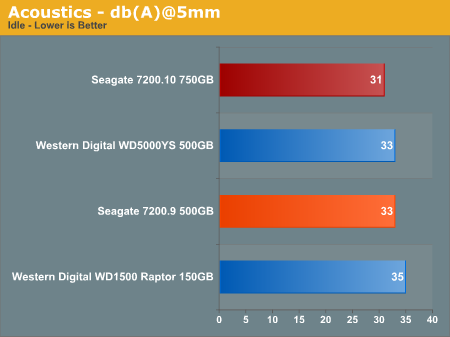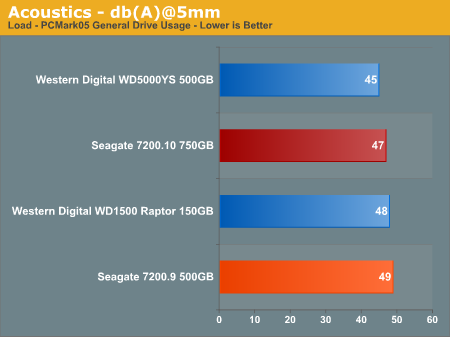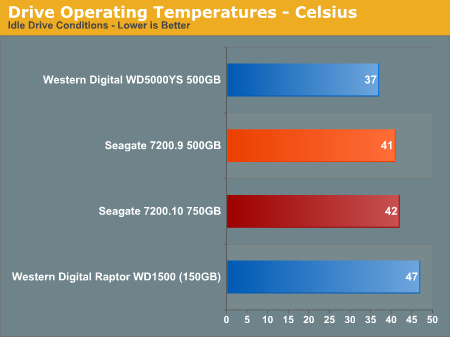Seagate Barracuda 7200.10 750GB: Size Does Matter
by Gary Key on May 18, 2006 9:00 AM EST- Posted in
- Storage
Acoustics
We have revised our acoustics testing methodology. Our acoustic test utilizes our standard test bed components but we implement AMD's Cool'n'Quiet technology and turn off the case fans to isolate as much case noise as possible during testing. Our OCZ power supply is virtually silent in these tests along with our fanless Asus 7600GS video card providing a further decrease in our case's ambient noise levels.Our acoustic tests are designed to measure the decibel levels while the system is at idle and also under load while running the General Hard Disk Drive Usage benchmark within PCMark 2005. We found through trail and error this particular benchmark produces controlled readings across a wide range of applications within the benchmark. This particular benchmark utilizes 60% reads and 40% writes within the trace playback file.
The measurements are taken at a distance of 5 millimeters from the rear and front of the drive being tested in order to minimize surrounding environmental noise. (Obviously, you won't have your head less than a centimeter away from the hard drive in normal computer use, but the important thing is the relative noise levels at this distance.) The reported measurements are based on an A-weighted decibel score that measures frequencies similar to the way the human ear responds to sound. We take a total of three measurements for each test. We then subtract the high and low scores and arrive at our findings by reporting the remaining score.


Seagate has advertised that the 7200.10 product is quieter in comparison to Barracuda 7200.9 in both idle and seek modes due to further refinements in their "Softsonic" motor technology. During our testing we came to a slightly different conclusion based upon our subjective test methodology. We found the 7200.10 drive recorded slightly better acoustic results in the instrument testing than the Seagate 7200.9 500GB drive but was subjectively louder than the 7200.9 500GB drive under load and almost matched our WD1500 Raptor in its very audible tone during full read requests.
This was surprising as the 7200.10 had the lowest idle rate of 31dBA in testing with full load tests generating a noticeable but not earth shattering 47dBA. The drive is basically a "silent" component in our case during idle conditions with only the occasional disc whirling but at full load the drive does generate a noticeable, almost thumping sound. In fact, although two of the drives tested are considered louder by our test equipment, the noise tone was slightly heavier which elicited our immediate attention to it. Of course, tone comments are generally very subjective so this drive could be considered quiet at full load when compared to other drives.
Thermals
Our thermal tests utilize sensor readings via the S.M.A.R.T. (Self-Monitoring, Analysis and Reporting Technology) capability of the drives and are reported by utilizing the Active SMART 2.42 utility. We test our drives in an enclosed case environment without the front fan operational to simulate temperatures that could conceivably be reached in a SFF or HTPC case design. We typically find the reported numbers drop anywhere from 18% to 25% on average when the front fan is operational.

We expected the 750GB 7200.10 drive to run very warm due to its size and platter count. The drive ran cooler than we expected, but the casing did become very warm to the touch - almost hot actually - which had us concerned until we noticed the reported numbers. Using the drive's integrated SMART thermal sensor and Active SMART we were able to monitor temperatures that went from 42°C at idle to 55°C under full load. These results were recorded in our enclosed Gigabyte case without the front fan operating to simulate the effects of utilizing drive in a small enclosure for HTPC duties or possibly a poorly ventilated case.
We then activated the 120mm fan in the front of the case and watched the full load temps quickly drop to 44°C and after a cool down period of 15 minutes the idle temps dropped to 37°C with full load testing resulting in 47°C readings. We would highly recommend some type of cooling in front of the drive, especially in a SFF or HTPC case. Though the temperatures we reached without a fan are well within the operating range of the drive, it is always preferable to keep hard drives cool to prolong their life, especially at a $500 price point.
The surprise showing once again is the Western Digital WD5000YS drive with reported temperatures at idle of 37°C and 45°C at full load. The WD Raptor 1500 has the ability to sizzle some bacon with idle temps at 47°C and full load at 58°C with a hardy recommendation of adding a fan directly in front of this unit. The Seagate 7200.9 500GB falls in the middle of the pack with temps at idle of 41°C and under full load at 53°C. While the temperatures of the 7200.9 in our testing show an advantage without cooling, the drive actually ran hotter than the 7200.10 when both were cooled with the front case fan. Our recorded temperatures after the same cool down period (ambient room temp equal) resulted in 38°C readings at idle and 49°C readings at full load.










44 Comments
View All Comments
Gary Key - Thursday, May 18, 2006 - link
Seagates claims are correct from an objecitve measurement, subjectively the drive was louder in our testing at full load with either read or write seeks. I added the subjective statement in this paragraph to convey what I was explaining further in the article. Thanks!! :)Questar - Thursday, May 18, 2006 - link
Gary, I hate to nick-pick, but even the revised version doesn't read well. You start off with Seagate's claim that the .10 is quieter than the .9, you say you found something different, and then talk about the .10 compared to the other drives.You need to say the drive is subjectivly louder than the .9 (if it was).
Gary Key - Thursday, May 18, 2006 - link
Sorry about that, I had the WD 500GB statement in the sentence and not the Seagate 500GB, that was confusing, read it so many times that I missed it. It should read better now. :)
Zoomer - Friday, May 26, 2006 - link
Why don't you invite more people down to down some blind comparative tests?That would sort out some subjectivity. :)
ROcHE - Thursday, May 18, 2006 - link
Will you guys review more standard sizes? Like 320GB or so.I have seen the 750GB model reviewed only so far.
Gary Key - Thursday, May 18, 2006 - link
We will in June, Seagate will be shipping press samples out later this month. I want to see the 200GB~320GB drive range just as much as everyone else. ;-)
ROcHE - Thursday, May 18, 2006 - link
It's already up for sale. ???Buy one and be the first to review :)
Gary Key - Thursday, May 18, 2006 - link
I already bought the the additional 750GB, WD1500, and WD5000YS for RAID results. I do not know how much more the wife will let me spend this month. ;-) Anyway, Seagate is getting ready to ship two of the 320s out to us. Hopefully, I can get the review in before Computex. I am pretty much convinced this is the drive that will define the sweet spot in the market for performance, capacity, and price.
Zoomer - Friday, May 26, 2006 - link
From the spec sheet, the 400GB one seems promising to be a contender. It has a higher head to platter ratio. :)ROcHE - Friday, May 19, 2006 - link
Can't wait to see the results.